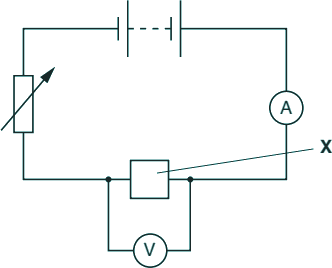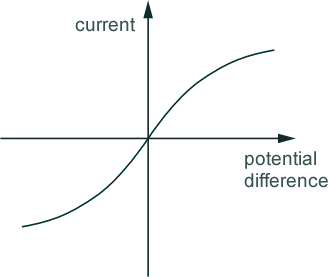GCSE Standard Questions: Electric Circuits
Q11. Anyanka builds a circuit to investigate the resistance of component X.

(a)
(i) What is the name of this component?

It is a variable resistor - or rheostat 
[1 mark]
(ii) Why is this component needed in this circuit?
It allows Anyanka to control/change/vary/increase/decrease the resistance/current in the circuit.
OR
It allows Anyanka to change the potential difference or voltage across component X. 
[1 mark]
(b) Anyanka uses the circuit to take a series of current and potential difference readings.
She then plots a graph of her results.
Here is a sketch of her graph:

(i) Look at the sketch graph shape and use it to identify the type of component X is.
The component is a filament bulb/lamp. 
[1 mark]
(ii) The resistance of component X varies as the potential difference changes. Describe how the graph shows this and explain why this happens.
Initially, with low p.d. the current is proportional to the p.d.  But then the gradient of the graph decreases as the potential difference across the component increases indicating that resistance increases as the p.d. across the component is increased.
But then the gradient of the graph decreases as the potential difference across the component increases indicating that resistance increases as the p.d. across the component is increased.  This happens because the rising temperature of the filament due to current passing through it increases its resistance.
This happens because the rising temperature of the filament due to current passing through it increases its resistance. 

[3 marks]
(c) Component X has a resistance of 16Ω when a current of 0.25A flows.
(i) Calculate the potential difference across component X.
V = IR 
V = 0.25 x 16 
V = 4 volts 
[3 marks]
(ii) Calculate the power of component X when a current of 0.25A flows.
P = IV 
P = 0.25 x 4 
P = 1.0 W 
[OR
P = I2R
P = 0.252 x 16
P = 1.0 W]
[3 marks]
(Total 12 marks)









